Foreign Direct Investment (FDI) and Multinational Company Dynamics
VerifiedAdded on 2023/01/18
|15
|4612
|21
Case Study
AI Summary
This case study examines the dynamics of multinational companies and foreign direct investment (FDI), focusing on the benefits and costs of outward FDI in developing nations. The study explores different FDI strategies and analyzes the impact of South-North and South-South investments. It introduces FDI concepts, including horizontal, vertical, and conglomerate types, and discusses FDI theories like location-based, product life cycle, and political theories to support its arguments. The case study also highlights the importance of government policies and regulations in attracting investment and fostering economic growth, while also considering the potential negative impacts of FDI. The conclusion emphasizes the positive role of FDI in improving a nation's economy through increased cash flow, job creation, infrastructure development, and improved living standards. An individual essay is also included, which discusses FDI's role in economic development and different types of FDI.
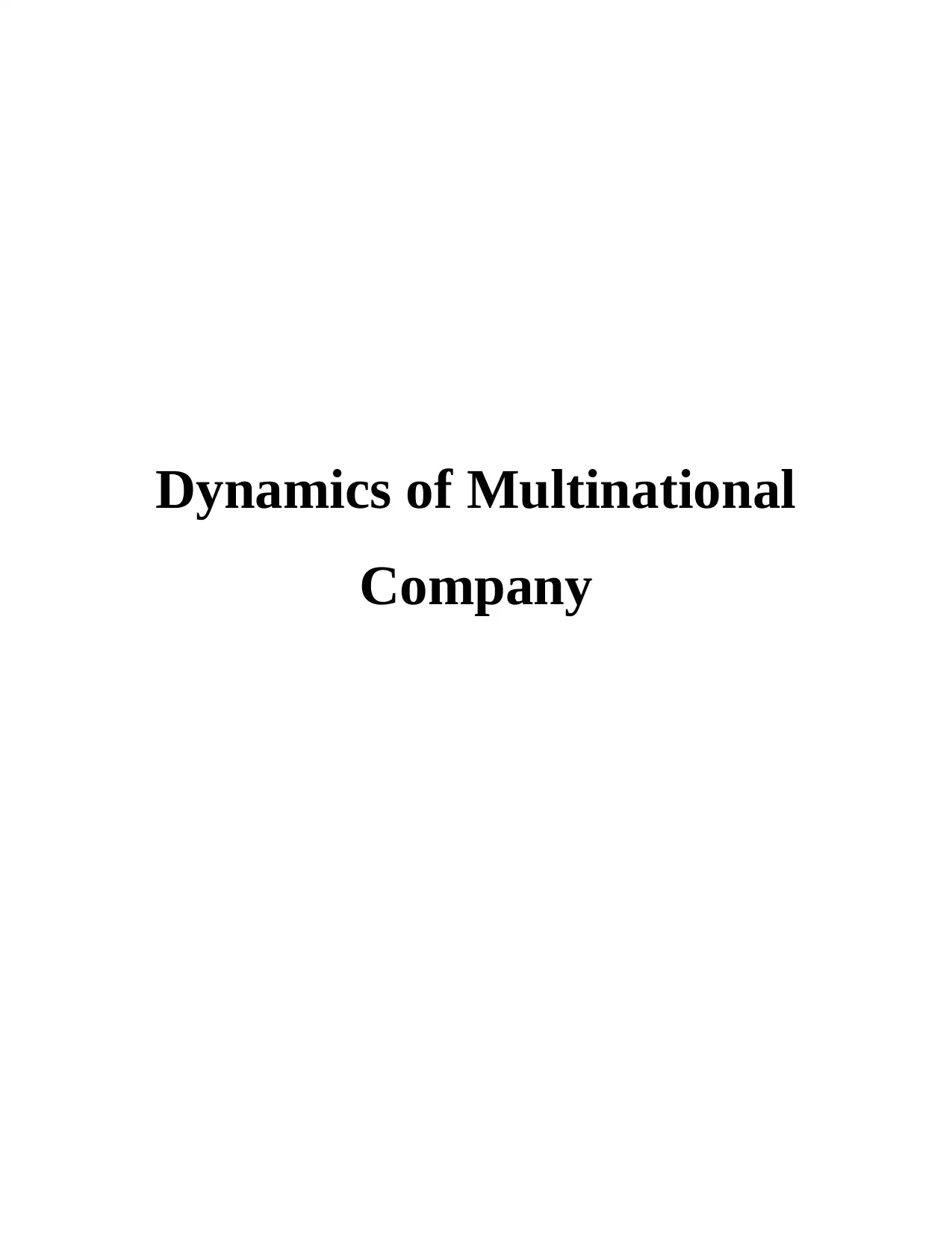
Dynamics of Multinational
Company
Company
Paraphrase This Document
Need a fresh take? Get an instant paraphrase of this document with our AI Paraphraser
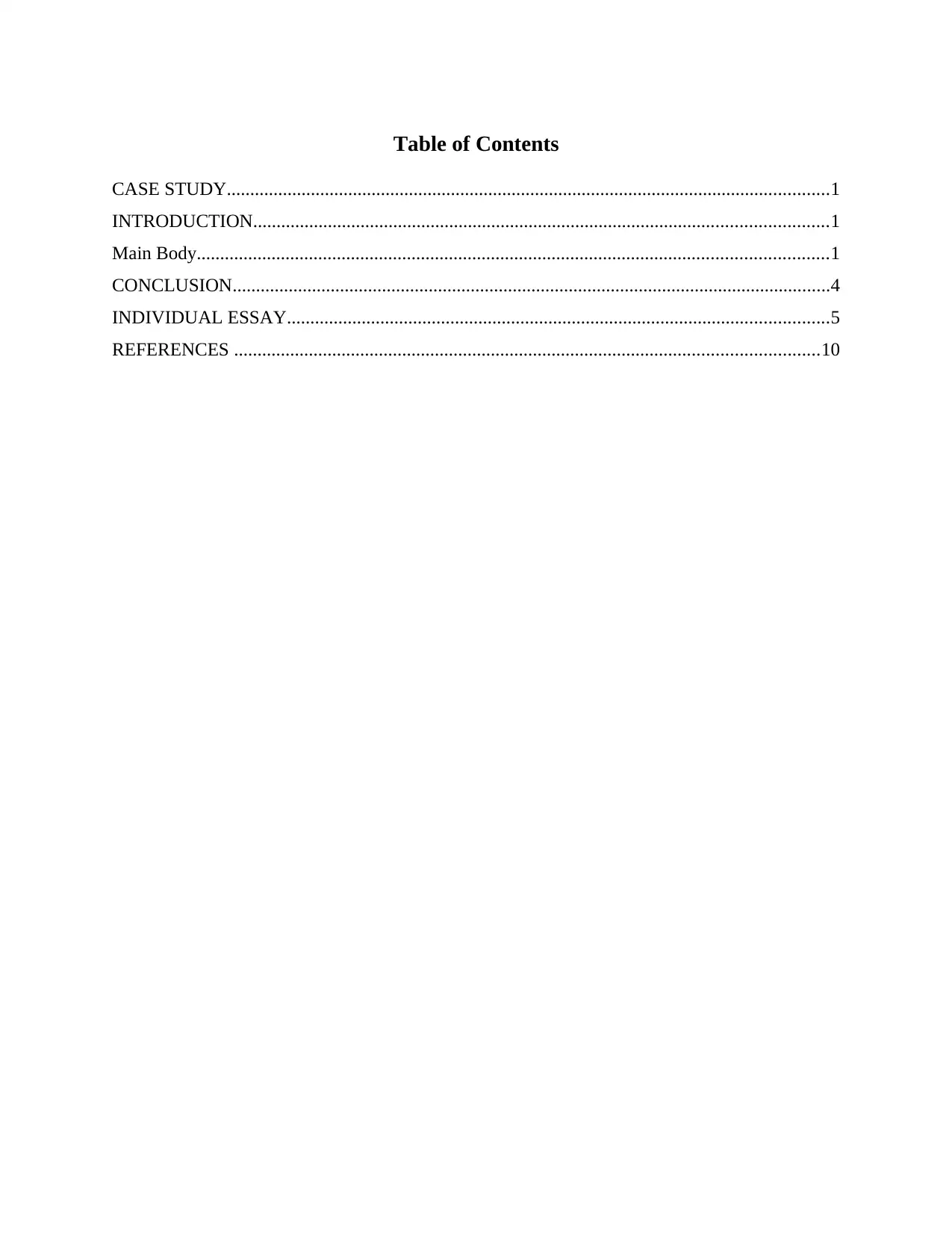
Table of Contents
CASE STUDY.................................................................................................................................1
INTRODUCTION...........................................................................................................................1
Main Body.......................................................................................................................................1
CONCLUSION................................................................................................................................4
INDIVIDUAL ESSAY....................................................................................................................5
REFERENCES .............................................................................................................................10
CASE STUDY.................................................................................................................................1
INTRODUCTION...........................................................................................................................1
Main Body.......................................................................................................................................1
CONCLUSION................................................................................................................................4
INDIVIDUAL ESSAY....................................................................................................................5
REFERENCES .............................................................................................................................10
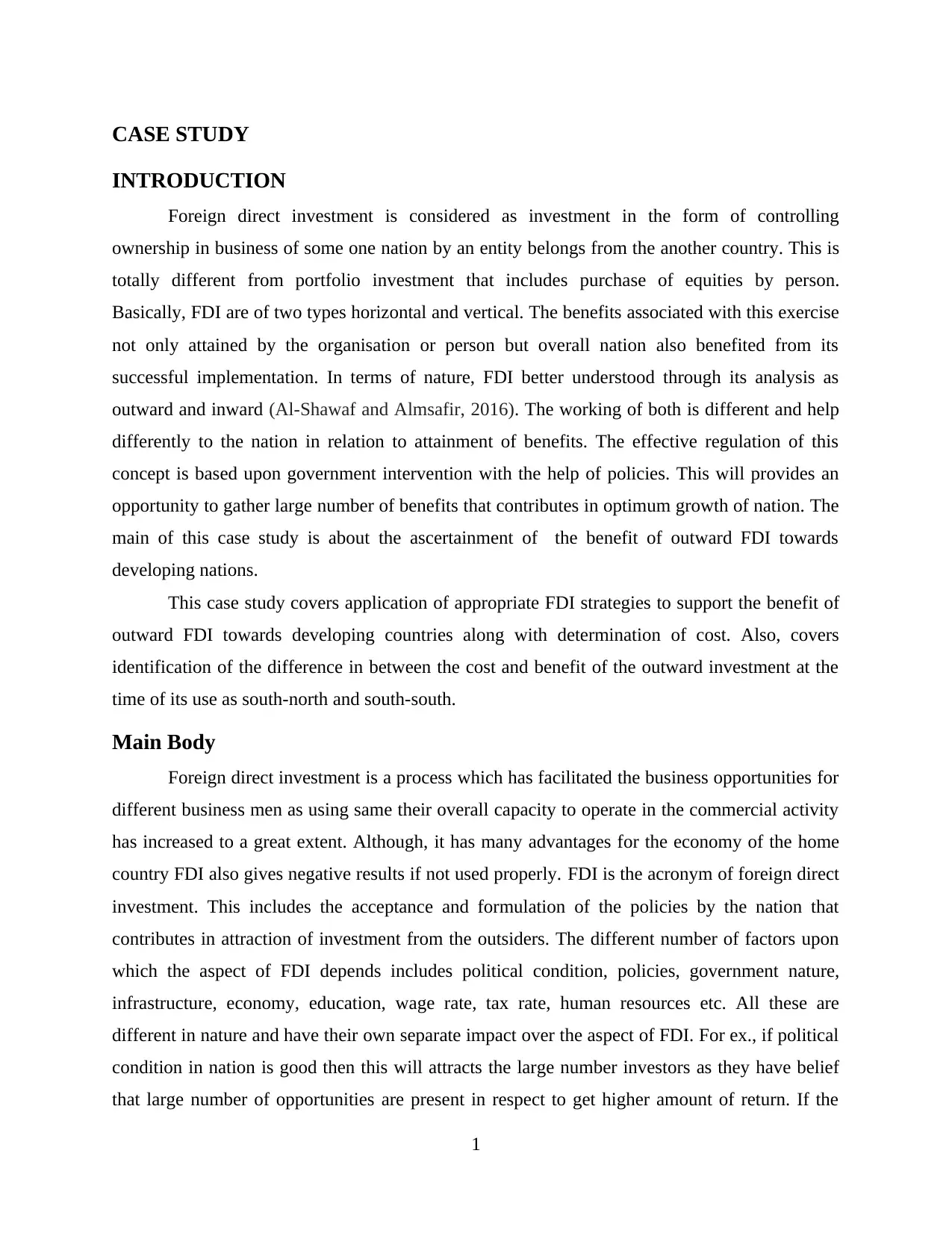
CASE STUDY
INTRODUCTION
Foreign direct investment is considered as investment in the form of controlling
ownership in business of some one nation by an entity belongs from the another country. This is
totally different from portfolio investment that includes purchase of equities by person.
Basically, FDI are of two types horizontal and vertical. The benefits associated with this exercise
not only attained by the organisation or person but overall nation also benefited from its
successful implementation. In terms of nature, FDI better understood through its analysis as
outward and inward (Al-Shawaf and Almsafir, 2016). The working of both is different and help
differently to the nation in relation to attainment of benefits. The effective regulation of this
concept is based upon government intervention with the help of policies. This will provides an
opportunity to gather large number of benefits that contributes in optimum growth of nation. The
main of this case study is about the ascertainment of the benefit of outward FDI towards
developing nations.
This case study covers application of appropriate FDI strategies to support the benefit of
outward FDI towards developing countries along with determination of cost. Also, covers
identification of the difference in between the cost and benefit of the outward investment at the
time of its use as south-north and south-south.
Main Body
Foreign direct investment is a process which has facilitated the business opportunities for
different business men as using same their overall capacity to operate in the commercial activity
has increased to a great extent. Although, it has many advantages for the economy of the home
country FDI also gives negative results if not used properly. FDI is the acronym of foreign direct
investment. This includes the acceptance and formulation of the policies by the nation that
contributes in attraction of investment from the outsiders. The different number of factors upon
which the aspect of FDI depends includes political condition, policies, government nature,
infrastructure, economy, education, wage rate, tax rate, human resources etc. All these are
different in nature and have their own separate impact over the aspect of FDI. For ex., if political
condition in nation is good then this will attracts the large number investors as they have belief
that large number of opportunities are present in respect to get higher amount of return. If the
1
INTRODUCTION
Foreign direct investment is considered as investment in the form of controlling
ownership in business of some one nation by an entity belongs from the another country. This is
totally different from portfolio investment that includes purchase of equities by person.
Basically, FDI are of two types horizontal and vertical. The benefits associated with this exercise
not only attained by the organisation or person but overall nation also benefited from its
successful implementation. In terms of nature, FDI better understood through its analysis as
outward and inward (Al-Shawaf and Almsafir, 2016). The working of both is different and help
differently to the nation in relation to attainment of benefits. The effective regulation of this
concept is based upon government intervention with the help of policies. This will provides an
opportunity to gather large number of benefits that contributes in optimum growth of nation. The
main of this case study is about the ascertainment of the benefit of outward FDI towards
developing nations.
This case study covers application of appropriate FDI strategies to support the benefit of
outward FDI towards developing countries along with determination of cost. Also, covers
identification of the difference in between the cost and benefit of the outward investment at the
time of its use as south-north and south-south.
Main Body
Foreign direct investment is a process which has facilitated the business opportunities for
different business men as using same their overall capacity to operate in the commercial activity
has increased to a great extent. Although, it has many advantages for the economy of the home
country FDI also gives negative results if not used properly. FDI is the acronym of foreign direct
investment. This includes the acceptance and formulation of the policies by the nation that
contributes in attraction of investment from the outsiders. The different number of factors upon
which the aspect of FDI depends includes political condition, policies, government nature,
infrastructure, economy, education, wage rate, tax rate, human resources etc. All these are
different in nature and have their own separate impact over the aspect of FDI. For ex., if political
condition in nation is good then this will attracts the large number investors as they have belief
that large number of opportunities are present in respect to get higher amount of return. If the
1
⊘ This is a preview!⊘
Do you want full access?
Subscribe today to unlock all pages.

Trusted by 1+ million students worldwide

situation is not good then will have direct negative impact over their perceptions and build the
image that they are unable to get the sufficient amount of returns. While going to analyse the tax
rate, the impact of this has main as if high tax rate is going to be levied then this will have direct
impact over the margin of profit. If margin is diminished then opportunities for investors are
going to be changed. This restricts them to made investment in the particular nation as they don't
have earn chances.
This concept is further bifurcated into the two different aspects i.e. Outward and Inward
FDI. Outward FDI is about the investment by the residents and organisations of home nation
towards host country (Boateng and et. al., 2015). On the other hand, Inward FDI is opposite in
nature. This is about acceptance of investment by the home country from the residents and
organisations of host nation. Outward FDI is considered as one of the new channel that
introduced for bring improvement in the economies of developing nations. The direct of
influence of the same is ascertained over country's investment competitiveness. This plays the
important role in the long term and sustainable growth of developing nations. The aspects which
are added due to successful implementation includes high amount of knowledge, new
technology, upgraded production process, high competitiveness, better managerial skills and
wide distribution network. To gain all these in maximum of number is depends over the
capability of government. Adoption of most beneficial option of Outward FDI help in addition of
above mentioned aspects optimum in nature. In addition to this, FDI introduces as an investment
within an organisation by an investor from another nation for which the international investor has
full control over the enterprise purchased. This is commonly made in open economics of country
that offer a knowledgeable employees and above average growth prospects or chances for the
capitalist, as opposed to fully regulated economies. FDI frequently involves provisions of
management as well as technology also (Damijan, Kostevc and Rojec, 2017). Along with this,
foreign direct investment takes place when a capitalist establishes international business
operations and acquires international business assets such as controlling interest or establishing
ownership in a foreign company. FDI mainly categorised into three forms which are vertical,
horizontal or conglomerate. In case of horizontal direct investment, investor establishing the
similar kind of business operation within a foreign country. Under vertical direct investment,
investor forms related business activities. Under conglomerate type of foreign direct investment,
2
image that they are unable to get the sufficient amount of returns. While going to analyse the tax
rate, the impact of this has main as if high tax rate is going to be levied then this will have direct
impact over the margin of profit. If margin is diminished then opportunities for investors are
going to be changed. This restricts them to made investment in the particular nation as they don't
have earn chances.
This concept is further bifurcated into the two different aspects i.e. Outward and Inward
FDI. Outward FDI is about the investment by the residents and organisations of home nation
towards host country (Boateng and et. al., 2015). On the other hand, Inward FDI is opposite in
nature. This is about acceptance of investment by the home country from the residents and
organisations of host nation. Outward FDI is considered as one of the new channel that
introduced for bring improvement in the economies of developing nations. The direct of
influence of the same is ascertained over country's investment competitiveness. This plays the
important role in the long term and sustainable growth of developing nations. The aspects which
are added due to successful implementation includes high amount of knowledge, new
technology, upgraded production process, high competitiveness, better managerial skills and
wide distribution network. To gain all these in maximum of number is depends over the
capability of government. Adoption of most beneficial option of Outward FDI help in addition of
above mentioned aspects optimum in nature. In addition to this, FDI introduces as an investment
within an organisation by an investor from another nation for which the international investor has
full control over the enterprise purchased. This is commonly made in open economics of country
that offer a knowledgeable employees and above average growth prospects or chances for the
capitalist, as opposed to fully regulated economies. FDI frequently involves provisions of
management as well as technology also (Damijan, Kostevc and Rojec, 2017). Along with this,
foreign direct investment takes place when a capitalist establishes international business
operations and acquires international business assets such as controlling interest or establishing
ownership in a foreign company. FDI mainly categorised into three forms which are vertical,
horizontal or conglomerate. In case of horizontal direct investment, investor establishing the
similar kind of business operation within a foreign country. Under vertical direct investment,
investor forms related business activities. Under conglomerate type of foreign direct investment,
2
Paraphrase This Document
Need a fresh take? Get an instant paraphrase of this document with our AI Paraphraser
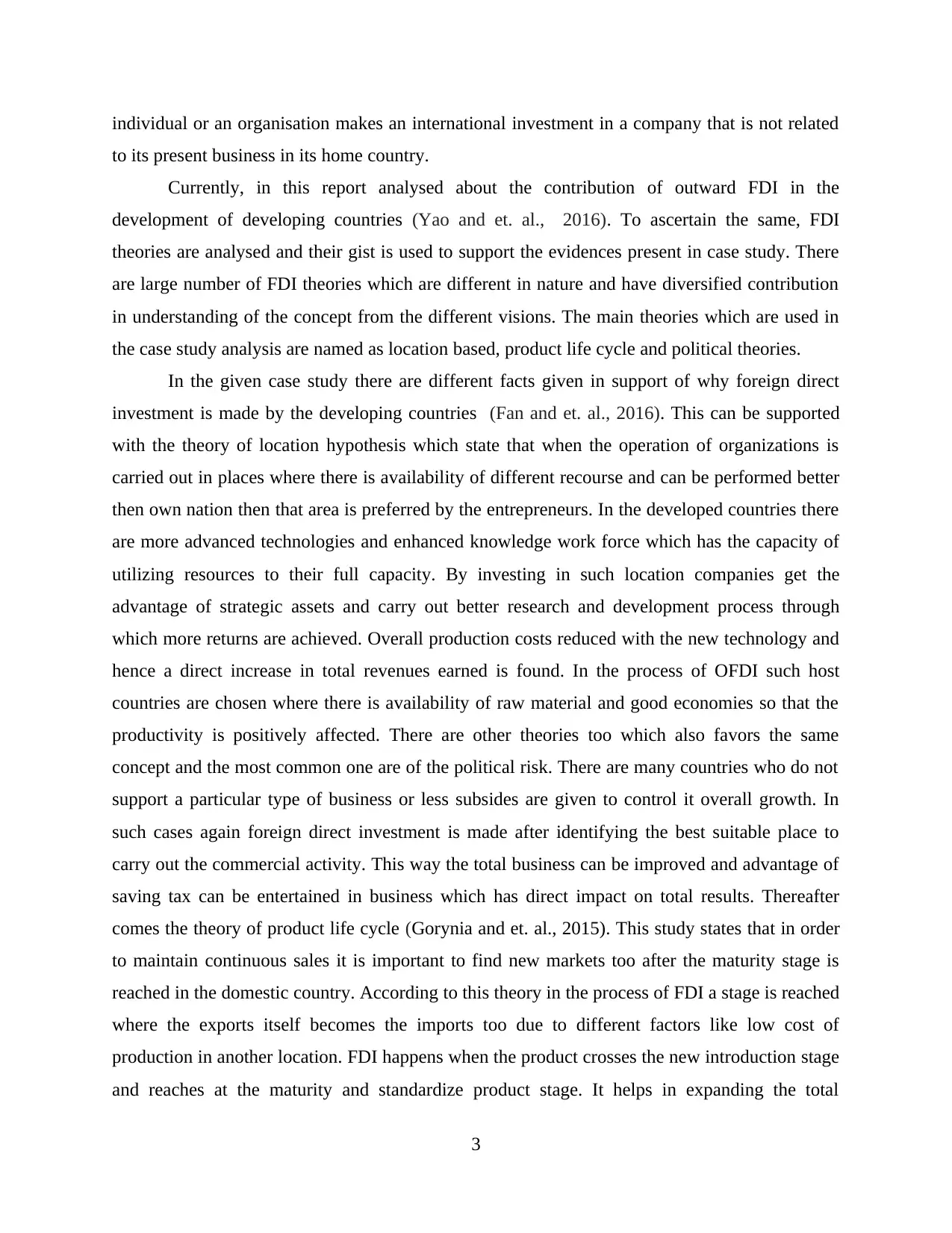
individual or an organisation makes an international investment in a company that is not related
to its present business in its home country.
Currently, in this report analysed about the contribution of outward FDI in the
development of developing countries (Yao and et. al., 2016). To ascertain the same, FDI
theories are analysed and their gist is used to support the evidences present in case study. There
are large number of FDI theories which are different in nature and have diversified contribution
in understanding of the concept from the different visions. The main theories which are used in
the case study analysis are named as location based, product life cycle and political theories.
In the given case study there are different facts given in support of why foreign direct
investment is made by the developing countries (Fan and et. al., 2016). This can be supported
with the theory of location hypothesis which state that when the operation of organizations is
carried out in places where there is availability of different recourse and can be performed better
then own nation then that area is preferred by the entrepreneurs. In the developed countries there
are more advanced technologies and enhanced knowledge work force which has the capacity of
utilizing resources to their full capacity. By investing in such location companies get the
advantage of strategic assets and carry out better research and development process through
which more returns are achieved. Overall production costs reduced with the new technology and
hence a direct increase in total revenues earned is found. In the process of OFDI such host
countries are chosen where there is availability of raw material and good economies so that the
productivity is positively affected. There are other theories too which also favors the same
concept and the most common one are of the political risk. There are many countries who do not
support a particular type of business or less subsides are given to control it overall growth. In
such cases again foreign direct investment is made after identifying the best suitable place to
carry out the commercial activity. This way the total business can be improved and advantage of
saving tax can be entertained in business which has direct impact on total results. Thereafter
comes the theory of product life cycle (Gorynia and et. al., 2015). This study states that in order
to maintain continuous sales it is important to find new markets too after the maturity stage is
reached in the domestic country. According to this theory in the process of FDI a stage is reached
where the exports itself becomes the imports too due to different factors like low cost of
production in another location. FDI happens when the product crosses the new introduction stage
and reaches at the maturity and standardize product stage. It helps in expanding the total
3
to its present business in its home country.
Currently, in this report analysed about the contribution of outward FDI in the
development of developing countries (Yao and et. al., 2016). To ascertain the same, FDI
theories are analysed and their gist is used to support the evidences present in case study. There
are large number of FDI theories which are different in nature and have diversified contribution
in understanding of the concept from the different visions. The main theories which are used in
the case study analysis are named as location based, product life cycle and political theories.
In the given case study there are different facts given in support of why foreign direct
investment is made by the developing countries (Fan and et. al., 2016). This can be supported
with the theory of location hypothesis which state that when the operation of organizations is
carried out in places where there is availability of different recourse and can be performed better
then own nation then that area is preferred by the entrepreneurs. In the developed countries there
are more advanced technologies and enhanced knowledge work force which has the capacity of
utilizing resources to their full capacity. By investing in such location companies get the
advantage of strategic assets and carry out better research and development process through
which more returns are achieved. Overall production costs reduced with the new technology and
hence a direct increase in total revenues earned is found. In the process of OFDI such host
countries are chosen where there is availability of raw material and good economies so that the
productivity is positively affected. There are other theories too which also favors the same
concept and the most common one are of the political risk. There are many countries who do not
support a particular type of business or less subsides are given to control it overall growth. In
such cases again foreign direct investment is made after identifying the best suitable place to
carry out the commercial activity. This way the total business can be improved and advantage of
saving tax can be entertained in business which has direct impact on total results. Thereafter
comes the theory of product life cycle (Gorynia and et. al., 2015). This study states that in order
to maintain continuous sales it is important to find new markets too after the maturity stage is
reached in the domestic country. According to this theory in the process of FDI a stage is reached
where the exports itself becomes the imports too due to different factors like low cost of
production in another location. FDI happens when the product crosses the new introduction stage
and reaches at the maturity and standardize product stage. It helps in expanding the total
3
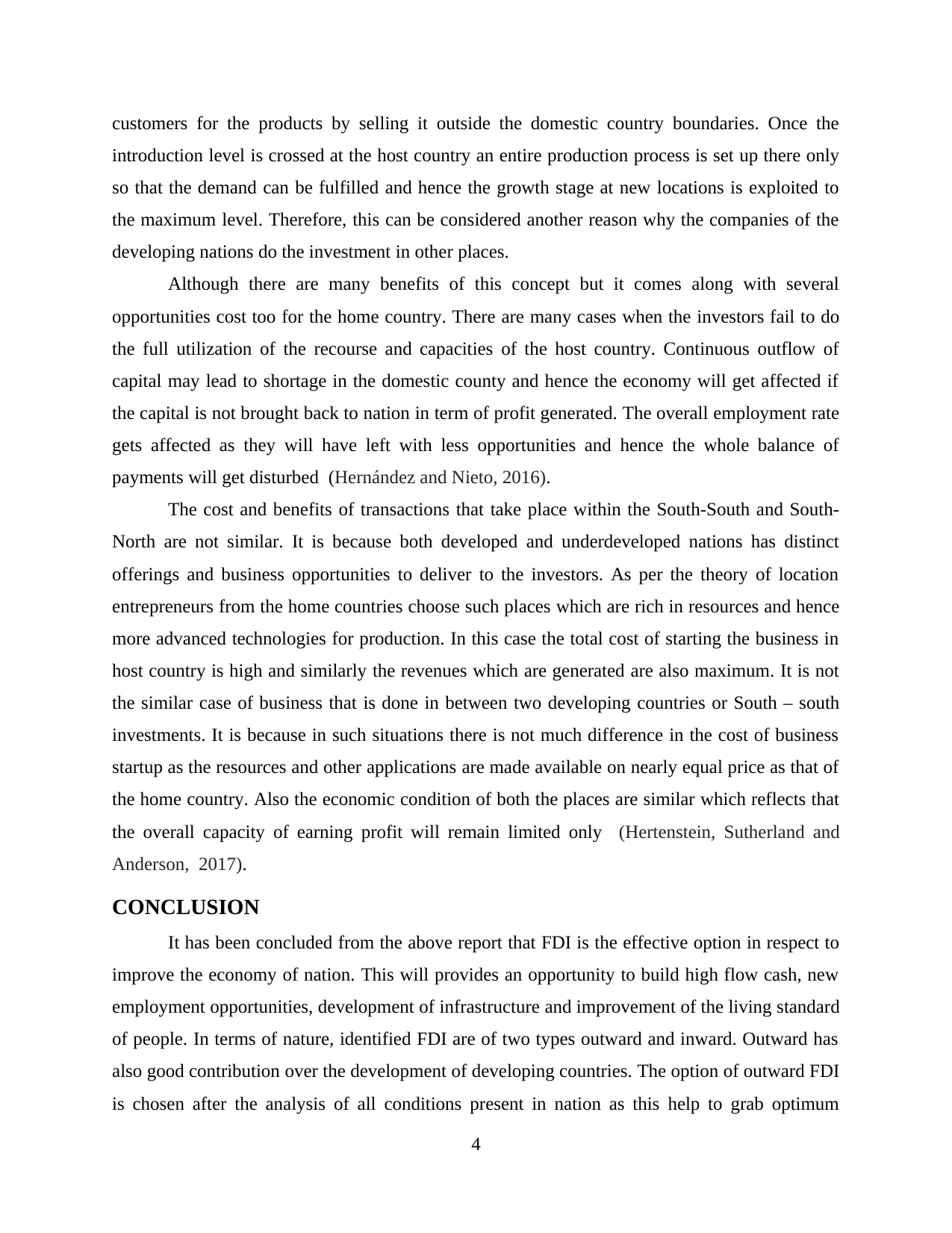
customers for the products by selling it outside the domestic country boundaries. Once the
introduction level is crossed at the host country an entire production process is set up there only
so that the demand can be fulfilled and hence the growth stage at new locations is exploited to
the maximum level. Therefore, this can be considered another reason why the companies of the
developing nations do the investment in other places.
Although there are many benefits of this concept but it comes along with several
opportunities cost too for the home country. There are many cases when the investors fail to do
the full utilization of the recourse and capacities of the host country. Continuous outflow of
capital may lead to shortage in the domestic county and hence the economy will get affected if
the capital is not brought back to nation in term of profit generated. The overall employment rate
gets affected as they will have left with less opportunities and hence the whole balance of
payments will get disturbed (Hernández and Nieto, 2016).
The cost and benefits of transactions that take place within the South-South and South-
North are not similar. It is because both developed and underdeveloped nations has distinct
offerings and business opportunities to deliver to the investors. As per the theory of location
entrepreneurs from the home countries choose such places which are rich in resources and hence
more advanced technologies for production. In this case the total cost of starting the business in
host country is high and similarly the revenues which are generated are also maximum. It is not
the similar case of business that is done in between two developing countries or South – south
investments. It is because in such situations there is not much difference in the cost of business
startup as the resources and other applications are made available on nearly equal price as that of
the home country. Also the economic condition of both the places are similar which reflects that
the overall capacity of earning profit will remain limited only (Hertenstein, Sutherland and
Anderson, 2017).
CONCLUSION
It has been concluded from the above report that FDI is the effective option in respect to
improve the economy of nation. This will provides an opportunity to build high flow cash, new
employment opportunities, development of infrastructure and improvement of the living standard
of people. In terms of nature, identified FDI are of two types outward and inward. Outward has
also good contribution over the development of developing countries. The option of outward FDI
is chosen after the analysis of all conditions present in nation as this help to grab optimum
4
introduction level is crossed at the host country an entire production process is set up there only
so that the demand can be fulfilled and hence the growth stage at new locations is exploited to
the maximum level. Therefore, this can be considered another reason why the companies of the
developing nations do the investment in other places.
Although there are many benefits of this concept but it comes along with several
opportunities cost too for the home country. There are many cases when the investors fail to do
the full utilization of the recourse and capacities of the host country. Continuous outflow of
capital may lead to shortage in the domestic county and hence the economy will get affected if
the capital is not brought back to nation in term of profit generated. The overall employment rate
gets affected as they will have left with less opportunities and hence the whole balance of
payments will get disturbed (Hernández and Nieto, 2016).
The cost and benefits of transactions that take place within the South-South and South-
North are not similar. It is because both developed and underdeveloped nations has distinct
offerings and business opportunities to deliver to the investors. As per the theory of location
entrepreneurs from the home countries choose such places which are rich in resources and hence
more advanced technologies for production. In this case the total cost of starting the business in
host country is high and similarly the revenues which are generated are also maximum. It is not
the similar case of business that is done in between two developing countries or South – south
investments. It is because in such situations there is not much difference in the cost of business
startup as the resources and other applications are made available on nearly equal price as that of
the home country. Also the economic condition of both the places are similar which reflects that
the overall capacity of earning profit will remain limited only (Hertenstein, Sutherland and
Anderson, 2017).
CONCLUSION
It has been concluded from the above report that FDI is the effective option in respect to
improve the economy of nation. This will provides an opportunity to build high flow cash, new
employment opportunities, development of infrastructure and improvement of the living standard
of people. In terms of nature, identified FDI are of two types outward and inward. Outward has
also good contribution over the development of developing countries. The option of outward FDI
is chosen after the analysis of all conditions present in nation as this help to grab optimum
4
⊘ This is a preview!⊘
Do you want full access?
Subscribe today to unlock all pages.

Trusted by 1+ million students worldwide
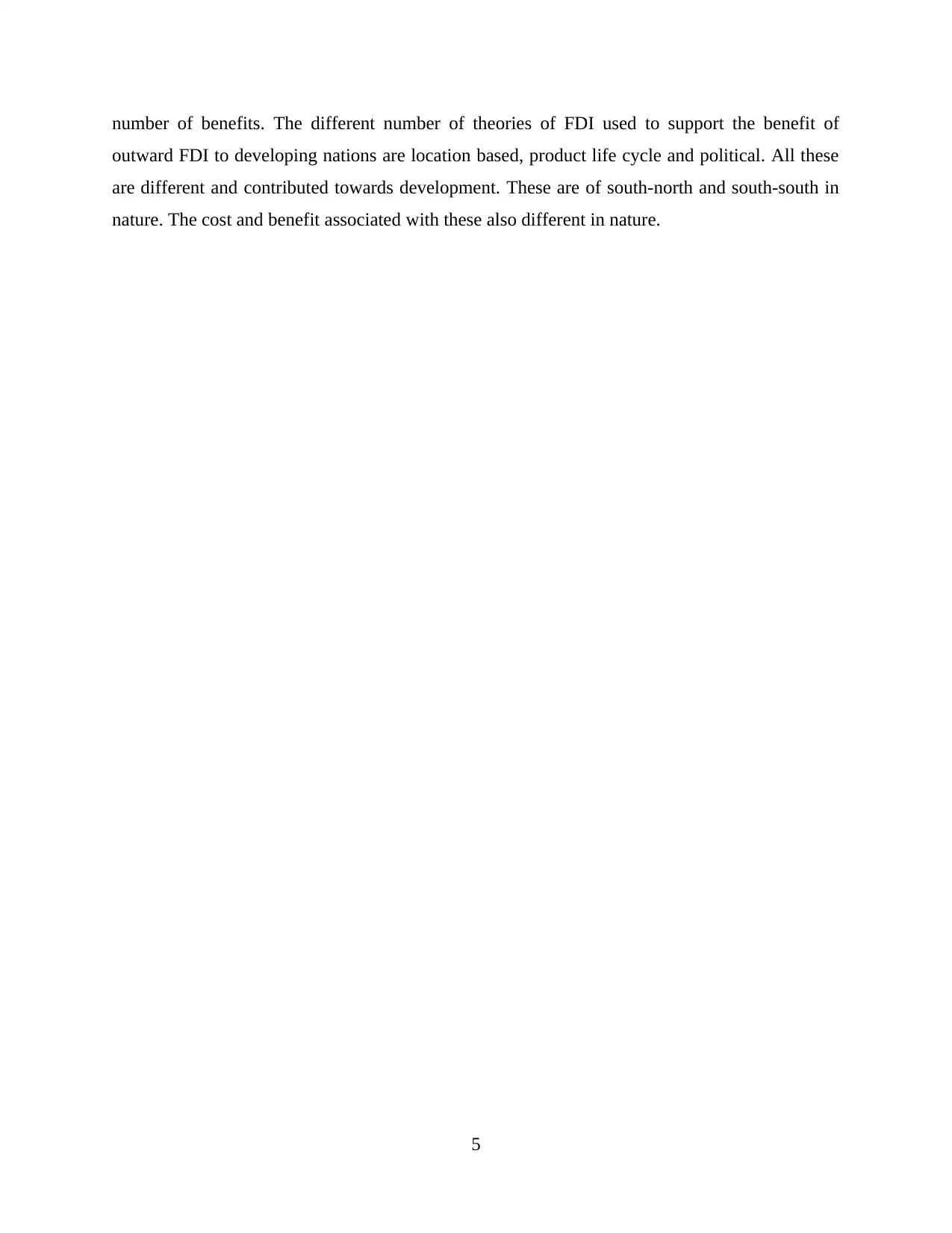
number of benefits. The different number of theories of FDI used to support the benefit of
outward FDI to developing nations are location based, product life cycle and political. All these
are different and contributed towards development. These are of south-north and south-south in
nature. The cost and benefit associated with these also different in nature.
5
outward FDI to developing nations are location based, product life cycle and political. All these
are different and contributed towards development. These are of south-north and south-south in
nature. The cost and benefit associated with these also different in nature.
5
Paraphrase This Document
Need a fresh take? Get an instant paraphrase of this document with our AI Paraphraser
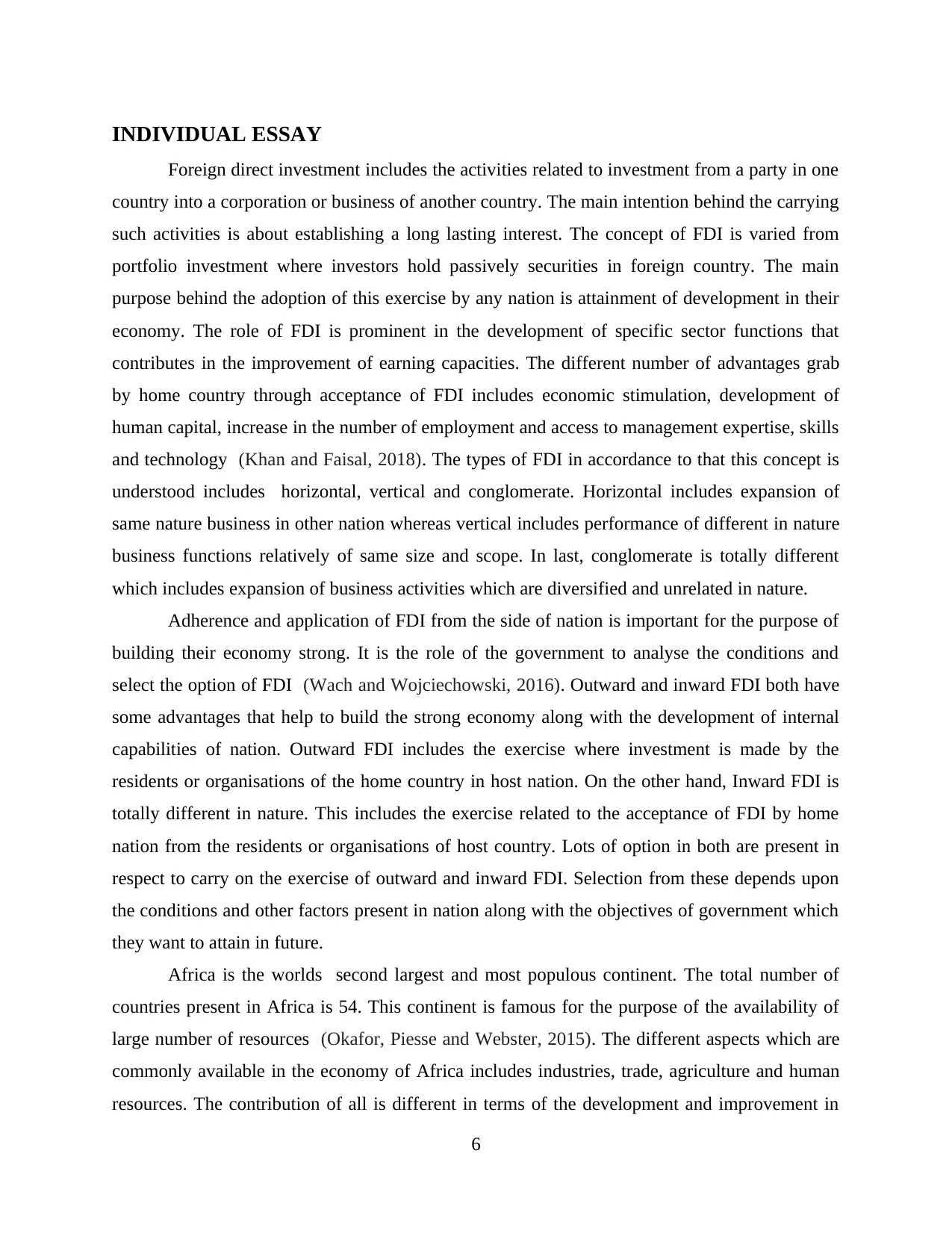
INDIVIDUAL ESSAY
Foreign direct investment includes the activities related to investment from a party in one
country into a corporation or business of another country. The main intention behind the carrying
such activities is about establishing a long lasting interest. The concept of FDI is varied from
portfolio investment where investors hold passively securities in foreign country. The main
purpose behind the adoption of this exercise by any nation is attainment of development in their
economy. The role of FDI is prominent in the development of specific sector functions that
contributes in the improvement of earning capacities. The different number of advantages grab
by home country through acceptance of FDI includes economic stimulation, development of
human capital, increase in the number of employment and access to management expertise, skills
and technology (Khan and Faisal, 2018). The types of FDI in accordance to that this concept is
understood includes horizontal, vertical and conglomerate. Horizontal includes expansion of
same nature business in other nation whereas vertical includes performance of different in nature
business functions relatively of same size and scope. In last, conglomerate is totally different
which includes expansion of business activities which are diversified and unrelated in nature.
Adherence and application of FDI from the side of nation is important for the purpose of
building their economy strong. It is the role of the government to analyse the conditions and
select the option of FDI (Wach and Wojciechowski, 2016). Outward and inward FDI both have
some advantages that help to build the strong economy along with the development of internal
capabilities of nation. Outward FDI includes the exercise where investment is made by the
residents or organisations of the home country in host nation. On the other hand, Inward FDI is
totally different in nature. This includes the exercise related to the acceptance of FDI by home
nation from the residents or organisations of host country. Lots of option in both are present in
respect to carry on the exercise of outward and inward FDI. Selection from these depends upon
the conditions and other factors present in nation along with the objectives of government which
they want to attain in future.
Africa is the worlds second largest and most populous continent. The total number of
countries present in Africa is 54. This continent is famous for the purpose of the availability of
large number of resources (Okafor, Piesse and Webster, 2015). The different aspects which are
commonly available in the economy of Africa includes industries, trade, agriculture and human
resources. The contribution of all is different in terms of the development and improvement in
6
Foreign direct investment includes the activities related to investment from a party in one
country into a corporation or business of another country. The main intention behind the carrying
such activities is about establishing a long lasting interest. The concept of FDI is varied from
portfolio investment where investors hold passively securities in foreign country. The main
purpose behind the adoption of this exercise by any nation is attainment of development in their
economy. The role of FDI is prominent in the development of specific sector functions that
contributes in the improvement of earning capacities. The different number of advantages grab
by home country through acceptance of FDI includes economic stimulation, development of
human capital, increase in the number of employment and access to management expertise, skills
and technology (Khan and Faisal, 2018). The types of FDI in accordance to that this concept is
understood includes horizontal, vertical and conglomerate. Horizontal includes expansion of
same nature business in other nation whereas vertical includes performance of different in nature
business functions relatively of same size and scope. In last, conglomerate is totally different
which includes expansion of business activities which are diversified and unrelated in nature.
Adherence and application of FDI from the side of nation is important for the purpose of
building their economy strong. It is the role of the government to analyse the conditions and
select the option of FDI (Wach and Wojciechowski, 2016). Outward and inward FDI both have
some advantages that help to build the strong economy along with the development of internal
capabilities of nation. Outward FDI includes the exercise where investment is made by the
residents or organisations of the home country in host nation. On the other hand, Inward FDI is
totally different in nature. This includes the exercise related to the acceptance of FDI by home
nation from the residents or organisations of host country. Lots of option in both are present in
respect to carry on the exercise of outward and inward FDI. Selection from these depends upon
the conditions and other factors present in nation along with the objectives of government which
they want to attain in future.
Africa is the worlds second largest and most populous continent. The total number of
countries present in Africa is 54. This continent is famous for the purpose of the availability of
large number of resources (Okafor, Piesse and Webster, 2015). The different aspects which are
commonly available in the economy of Africa includes industries, trade, agriculture and human
resources. The contribution of all is different in terms of the development and improvement in
6
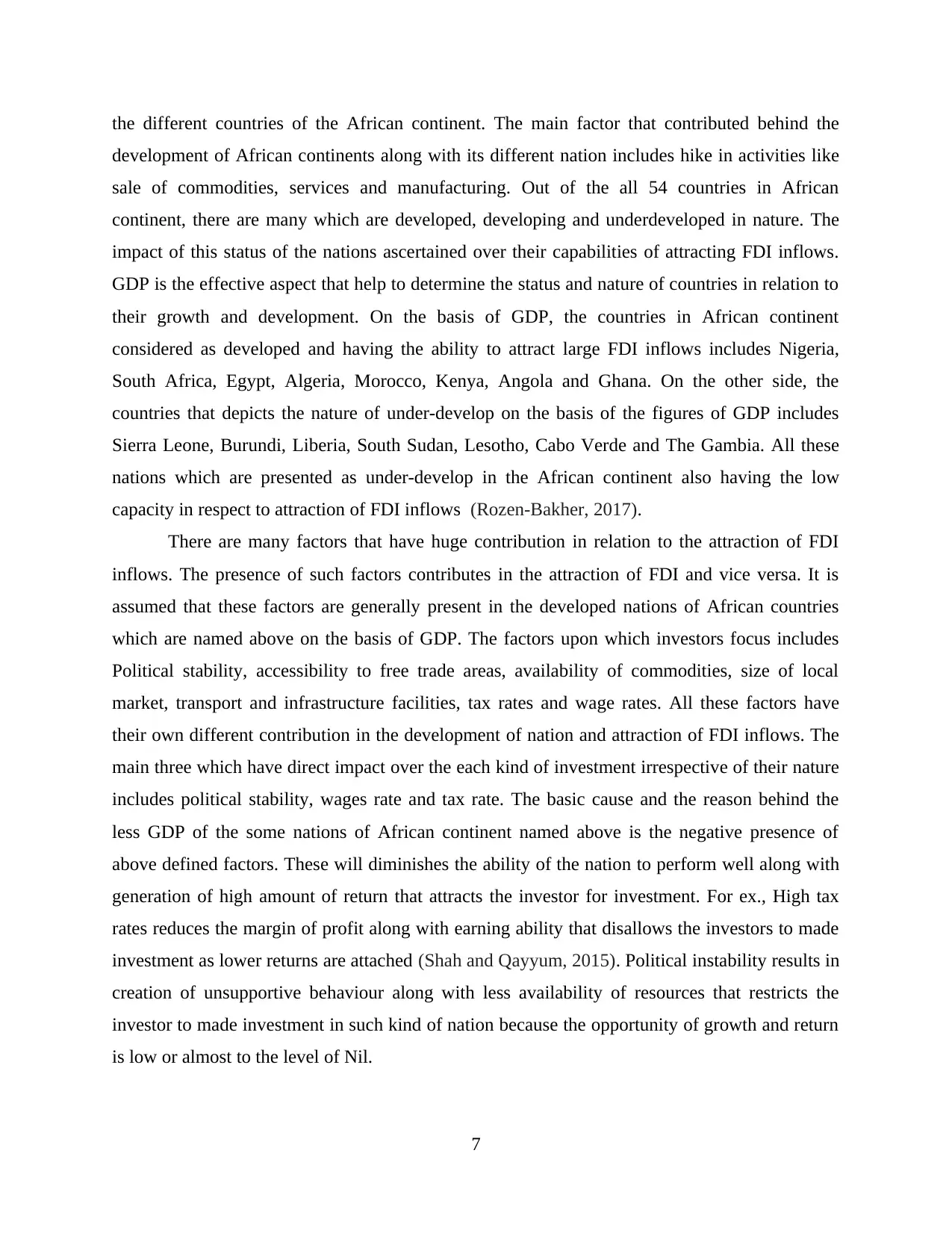
the different countries of the African continent. The main factor that contributed behind the
development of African continents along with its different nation includes hike in activities like
sale of commodities, services and manufacturing. Out of the all 54 countries in African
continent, there are many which are developed, developing and underdeveloped in nature. The
impact of this status of the nations ascertained over their capabilities of attracting FDI inflows.
GDP is the effective aspect that help to determine the status and nature of countries in relation to
their growth and development. On the basis of GDP, the countries in African continent
considered as developed and having the ability to attract large FDI inflows includes Nigeria,
South Africa, Egypt, Algeria, Morocco, Kenya, Angola and Ghana. On the other side, the
countries that depicts the nature of under-develop on the basis of the figures of GDP includes
Sierra Leone, Burundi, Liberia, South Sudan, Lesotho, Cabo Verde and The Gambia. All these
nations which are presented as under-develop in the African continent also having the low
capacity in respect to attraction of FDI inflows (Rozen-Bakher, 2017).
There are many factors that have huge contribution in relation to the attraction of FDI
inflows. The presence of such factors contributes in the attraction of FDI and vice versa. It is
assumed that these factors are generally present in the developed nations of African countries
which are named above on the basis of GDP. The factors upon which investors focus includes
Political stability, accessibility to free trade areas, availability of commodities, size of local
market, transport and infrastructure facilities, tax rates and wage rates. All these factors have
their own different contribution in the development of nation and attraction of FDI inflows. The
main three which have direct impact over the each kind of investment irrespective of their nature
includes political stability, wages rate and tax rate. The basic cause and the reason behind the
less GDP of the some nations of African continent named above is the negative presence of
above defined factors. These will diminishes the ability of the nation to perform well along with
generation of high amount of return that attracts the investor for investment. For ex., High tax
rates reduces the margin of profit along with earning ability that disallows the investors to made
investment as lower returns are attached (Shah and Qayyum, 2015). Political instability results in
creation of unsupportive behaviour along with less availability of resources that restricts the
investor to made investment in such kind of nation because the opportunity of growth and return
is low or almost to the level of Nil.
7
development of African continents along with its different nation includes hike in activities like
sale of commodities, services and manufacturing. Out of the all 54 countries in African
continent, there are many which are developed, developing and underdeveloped in nature. The
impact of this status of the nations ascertained over their capabilities of attracting FDI inflows.
GDP is the effective aspect that help to determine the status and nature of countries in relation to
their growth and development. On the basis of GDP, the countries in African continent
considered as developed and having the ability to attract large FDI inflows includes Nigeria,
South Africa, Egypt, Algeria, Morocco, Kenya, Angola and Ghana. On the other side, the
countries that depicts the nature of under-develop on the basis of the figures of GDP includes
Sierra Leone, Burundi, Liberia, South Sudan, Lesotho, Cabo Verde and The Gambia. All these
nations which are presented as under-develop in the African continent also having the low
capacity in respect to attraction of FDI inflows (Rozen-Bakher, 2017).
There are many factors that have huge contribution in relation to the attraction of FDI
inflows. The presence of such factors contributes in the attraction of FDI and vice versa. It is
assumed that these factors are generally present in the developed nations of African countries
which are named above on the basis of GDP. The factors upon which investors focus includes
Political stability, accessibility to free trade areas, availability of commodities, size of local
market, transport and infrastructure facilities, tax rates and wage rates. All these factors have
their own different contribution in the development of nation and attraction of FDI inflows. The
main three which have direct impact over the each kind of investment irrespective of their nature
includes political stability, wages rate and tax rate. The basic cause and the reason behind the
less GDP of the some nations of African continent named above is the negative presence of
above defined factors. These will diminishes the ability of the nation to perform well along with
generation of high amount of return that attracts the investor for investment. For ex., High tax
rates reduces the margin of profit along with earning ability that disallows the investors to made
investment as lower returns are attached (Shah and Qayyum, 2015). Political instability results in
creation of unsupportive behaviour along with less availability of resources that restricts the
investor to made investment in such kind of nation because the opportunity of growth and return
is low or almost to the level of Nil.
7
⊘ This is a preview!⊘
Do you want full access?
Subscribe today to unlock all pages.

Trusted by 1+ million students worldwide
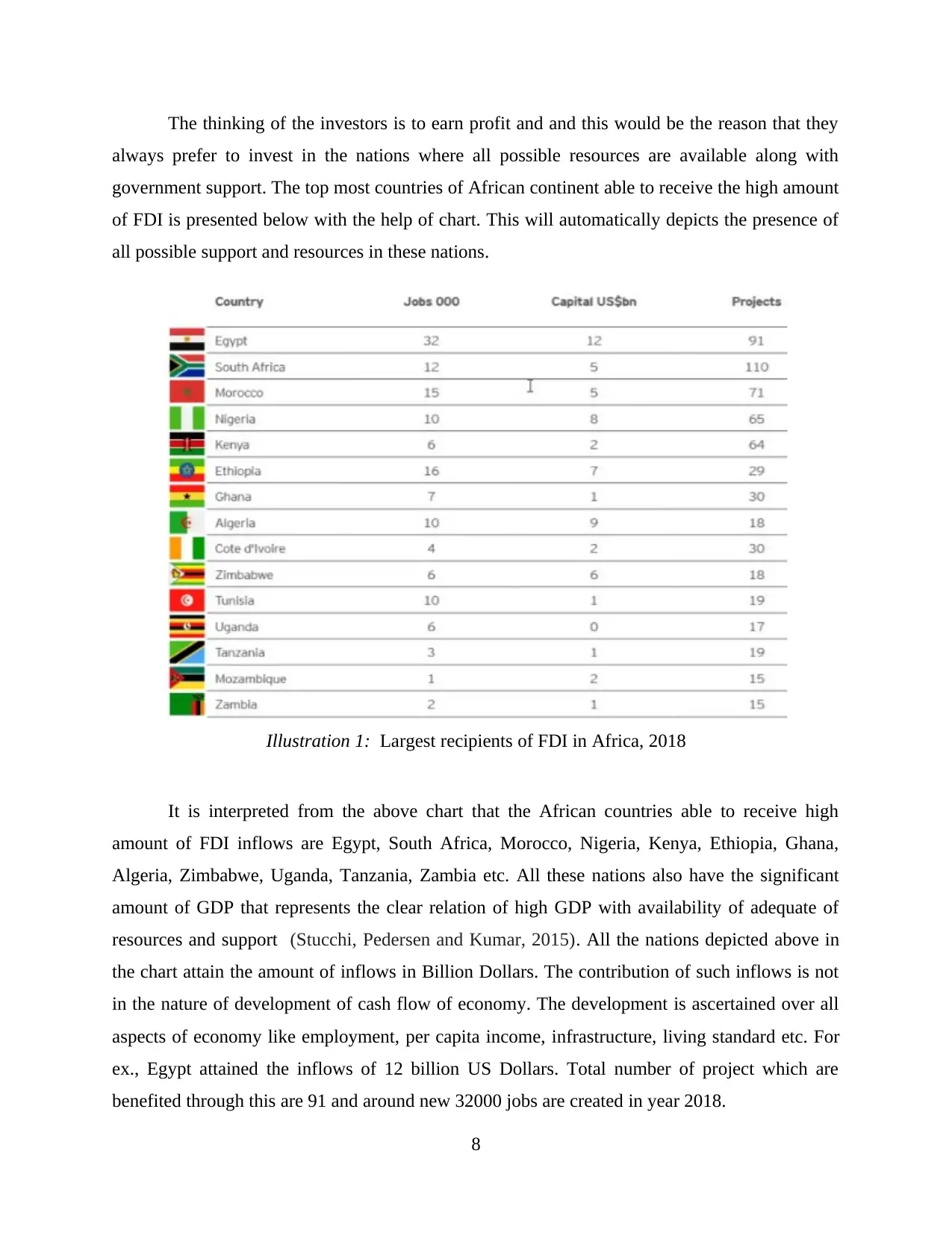
The thinking of the investors is to earn profit and and this would be the reason that they
always prefer to invest in the nations where all possible resources are available along with
government support. The top most countries of African continent able to receive the high amount
of FDI is presented below with the help of chart. This will automatically depicts the presence of
all possible support and resources in these nations.
It is interpreted from the above chart that the African countries able to receive high
amount of FDI inflows are Egypt, South Africa, Morocco, Nigeria, Kenya, Ethiopia, Ghana,
Algeria, Zimbabwe, Uganda, Tanzania, Zambia etc. All these nations also have the significant
amount of GDP that represents the clear relation of high GDP with availability of adequate of
resources and support (Stucchi, Pedersen and Kumar, 2015). All the nations depicted above in
the chart attain the amount of inflows in Billion Dollars. The contribution of such inflows is not
in the nature of development of cash flow of economy. The development is ascertained over all
aspects of economy like employment, per capita income, infrastructure, living standard etc. For
ex., Egypt attained the inflows of 12 billion US Dollars. Total number of project which are
benefited through this are 91 and around new 32000 jobs are created in year 2018.
8
Illustration 1: Largest recipients of FDI in Africa, 2018
always prefer to invest in the nations where all possible resources are available along with
government support. The top most countries of African continent able to receive the high amount
of FDI is presented below with the help of chart. This will automatically depicts the presence of
all possible support and resources in these nations.
It is interpreted from the above chart that the African countries able to receive high
amount of FDI inflows are Egypt, South Africa, Morocco, Nigeria, Kenya, Ethiopia, Ghana,
Algeria, Zimbabwe, Uganda, Tanzania, Zambia etc. All these nations also have the significant
amount of GDP that represents the clear relation of high GDP with availability of adequate of
resources and support (Stucchi, Pedersen and Kumar, 2015). All the nations depicted above in
the chart attain the amount of inflows in Billion Dollars. The contribution of such inflows is not
in the nature of development of cash flow of economy. The development is ascertained over all
aspects of economy like employment, per capita income, infrastructure, living standard etc. For
ex., Egypt attained the inflows of 12 billion US Dollars. Total number of project which are
benefited through this are 91 and around new 32000 jobs are created in year 2018.
8
Illustration 1: Largest recipients of FDI in Africa, 2018
Paraphrase This Document
Need a fresh take? Get an instant paraphrase of this document with our AI Paraphraser
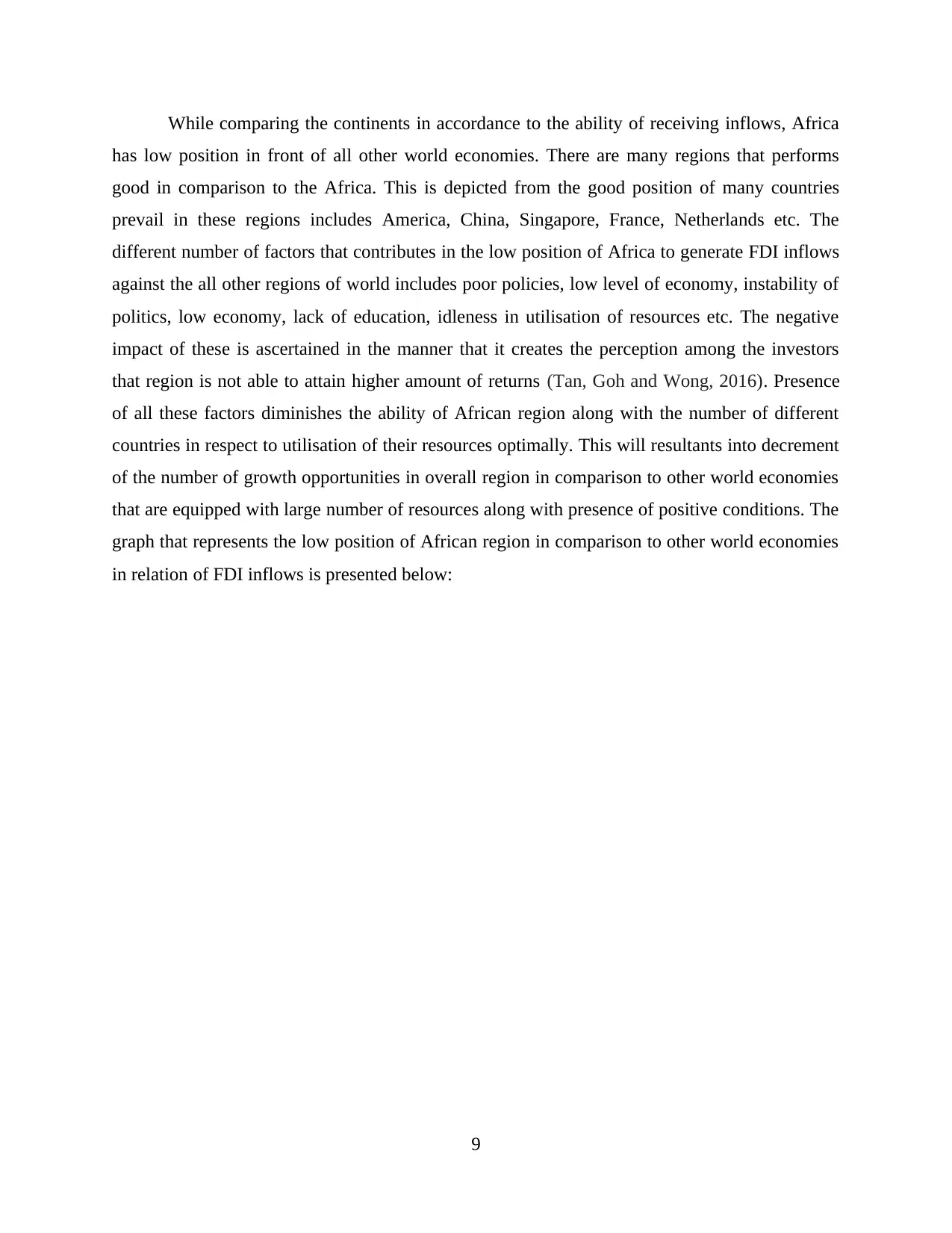
While comparing the continents in accordance to the ability of receiving inflows, Africa
has low position in front of all other world economies. There are many regions that performs
good in comparison to the Africa. This is depicted from the good position of many countries
prevail in these regions includes America, China, Singapore, France, Netherlands etc. The
different number of factors that contributes in the low position of Africa to generate FDI inflows
against the all other regions of world includes poor policies, low level of economy, instability of
politics, low economy, lack of education, idleness in utilisation of resources etc. The negative
impact of these is ascertained in the manner that it creates the perception among the investors
that region is not able to attain higher amount of returns (Tan, Goh and Wong, 2016). Presence
of all these factors diminishes the ability of African region along with the number of different
countries in respect to utilisation of their resources optimally. This will resultants into decrement
of the number of growth opportunities in overall region in comparison to other world economies
that are equipped with large number of resources along with presence of positive conditions. The
graph that represents the low position of African region in comparison to other world economies
in relation of FDI inflows is presented below:
9
has low position in front of all other world economies. There are many regions that performs
good in comparison to the Africa. This is depicted from the good position of many countries
prevail in these regions includes America, China, Singapore, France, Netherlands etc. The
different number of factors that contributes in the low position of Africa to generate FDI inflows
against the all other regions of world includes poor policies, low level of economy, instability of
politics, low economy, lack of education, idleness in utilisation of resources etc. The negative
impact of these is ascertained in the manner that it creates the perception among the investors
that region is not able to attain higher amount of returns (Tan, Goh and Wong, 2016). Presence
of all these factors diminishes the ability of African region along with the number of different
countries in respect to utilisation of their resources optimally. This will resultants into decrement
of the number of growth opportunities in overall region in comparison to other world economies
that are equipped with large number of resources along with presence of positive conditions. The
graph that represents the low position of African region in comparison to other world economies
in relation of FDI inflows is presented below:
9
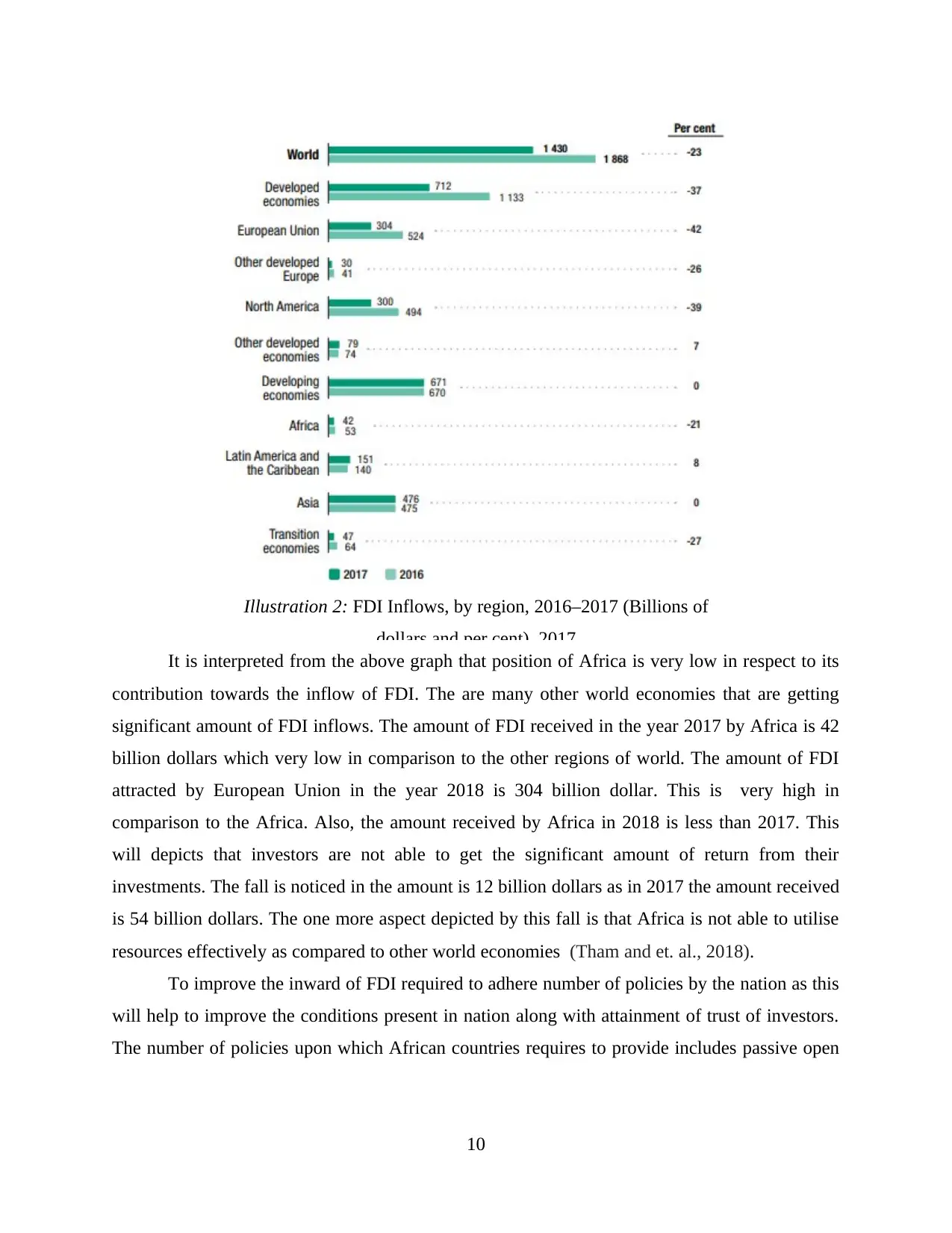
Illustration 2: FDI Inflows, by region, 2016–2017 (Billions of
dollars and per cent), 2017
It is interpreted from the above graph that position of Africa is very low in respect to its
contribution towards the inflow of FDI. The are many other world economies that are getting
significant amount of FDI inflows. The amount of FDI received in the year 2017 by Africa is 42
billion dollars which very low in comparison to the other regions of world. The amount of FDI
attracted by European Union in the year 2018 is 304 billion dollar. This is very high in
comparison to the Africa. Also, the amount received by Africa in 2018 is less than 2017. This
will depicts that investors are not able to get the significant amount of return from their
investments. The fall is noticed in the amount is 12 billion dollars as in 2017 the amount received
is 54 billion dollars. The one more aspect depicted by this fall is that Africa is not able to utilise
resources effectively as compared to other world economies (Tham and et. al., 2018).
To improve the inward of FDI required to adhere number of policies by the nation as this
will help to improve the conditions present in nation along with attainment of trust of investors.
The number of policies upon which African countries requires to provide includes passive open
10
dollars and per cent), 2017
It is interpreted from the above graph that position of Africa is very low in respect to its
contribution towards the inflow of FDI. The are many other world economies that are getting
significant amount of FDI inflows. The amount of FDI received in the year 2017 by Africa is 42
billion dollars which very low in comparison to the other regions of world. The amount of FDI
attracted by European Union in the year 2018 is 304 billion dollar. This is very high in
comparison to the Africa. Also, the amount received by Africa in 2018 is less than 2017. This
will depicts that investors are not able to get the significant amount of return from their
investments. The fall is noticed in the amount is 12 billion dollars as in 2017 the amount received
is 54 billion dollars. The one more aspect depicted by this fall is that Africa is not able to utilise
resources effectively as compared to other world economies (Tham and et. al., 2018).
To improve the inward of FDI required to adhere number of policies by the nation as this
will help to improve the conditions present in nation along with attainment of trust of investors.
The number of policies upon which African countries requires to provide includes passive open
10
⊘ This is a preview!⊘
Do you want full access?
Subscribe today to unlock all pages.

Trusted by 1+ million students worldwide
1 out of 15
Related Documents
Your All-in-One AI-Powered Toolkit for Academic Success.
+13062052269
info@desklib.com
Available 24*7 on WhatsApp / Email
![[object Object]](/_next/static/media/star-bottom.7253800d.svg)
Unlock your academic potential
Copyright © 2020–2025 A2Z Services. All Rights Reserved. Developed and managed by ZUCOL.





